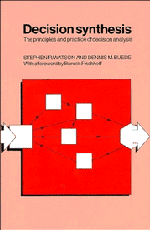5 - DECISION ANALYSIS IN ORGANIZATIONS
from PART I - THEORY
Published online by Cambridge University Press: 16 September 2009
Summary
INTRODUCTION
In following through the discussion of decision theory that we presented in Chapter 3 the reader will have become aware that it is concerned with how an individual person might reasonably make decisions. Most significant decisions, however, are not made by an individual acting alone but by groups of people. Many examples spring to mind: committee decisions determined by a majority vote; the results of the adversarial process in a law court; or the subtle combination of political pressures that determine events in government. It is also the case that most practical applications of decision analysis are carried out in an organizational setting and focus on organizational decision-making rather than on improving the decision processes of a single decision-maker. It is most important, then, to ask how a normative theory developed to guide individuals can have a role to play in organizational decision-making. It clearly does have such a role in practice; we must ask if that role is valid, or simply bogus in that it does not lead to better decisions.
To do this we look first at what is known about how decisions are in fact made in organizations. The literature on this is diverse and enormous, and several different intellectual traditions have contributed to our understanding.
- Type
- Chapter
- Information
- Decision SynthesisThe Principles and Practice of Decision Analysis, pp. 101 - 120Publisher: Cambridge University PressPrint publication year: 1988



